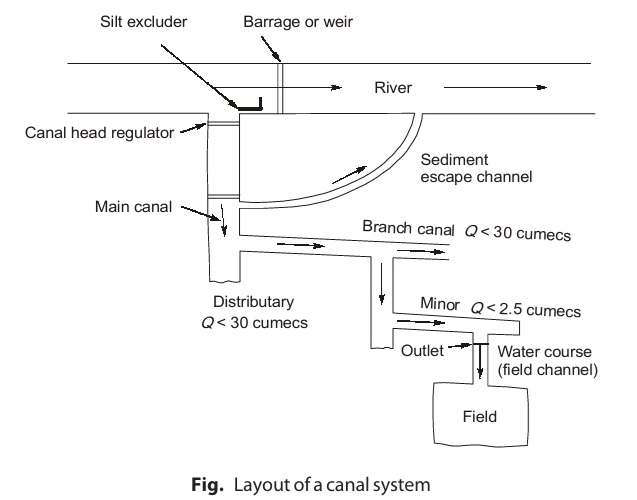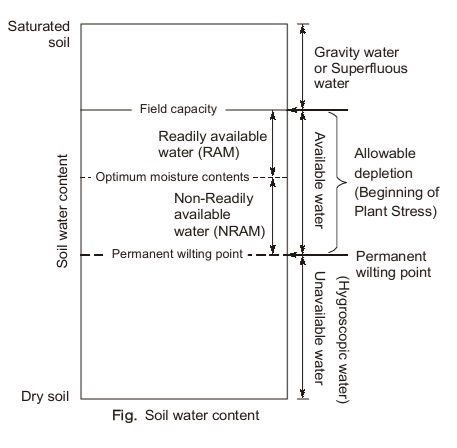Intensity of irrigation (Seasonal and Annual)
Intensity of irrigation
To avoid intensive irrigation of a particular area which may cause water logging, salinity and malaria etc. entire cultivated portion of CCA is not irrigated at one time (one season). Some field are left unirrigated in one season and water is supplied to them in next season. Only a small percentage of CCA is brought under irrigation over a given season. This percentage of CCA proposed to be irrigated in a given season is called intensity of irrigation of that season, or seasonal intensity of irrigation.
Similarly, intensity of irrigation can be defined for an entire year (inclusive of two or more crop season), then it is called annual irrigation intensity or annual intensity of irrigation. Annual intensity of irrigation (AII) is obtained by dividing the gross irrigated area (i.e. sum of total area irrigated once in year and area irrigated more than once in that year) by culturable command area. Annual intensity of irrigation is sum of intensities of irrigation of all season of the year. It may be more than 100%.
Crop Period
Crop period is the total time period from the instant of sowing of the crop to the instant of harvesting of the crop.
Base Period
Base Period is the total time period from the first watering done for the preparation of land to the last watering done before its harvesting. Although crop period is greater than base period but for practical purposes, they are taken as one and generally expressed in days. Crop period and base period are expressed in days.
Delta
Delta is total depth of water (generally in cm) required by a crop during the entire period the crop is in field. It is denoted by symbol D. It can also be defined as depth of which water would stand on irrigated area, if total quantity of water required for a crop during its base period (B) were to stand above the surface without percolation or evaporation.
Average Approximate Values of Delta for Certain Important Crops in India
| Serial No. | Crop | Delta on field |
|---|---|---|
| 1. | Sugarcane | 120 cm (48²) |
| 2. | Rice | 120 cm (48²) |
| 3. | Tobacco | 75 cm (30²) |
| 4. | Garden fruits | 60 cm (24²) |
| 5. | Cotton | 50 cm (22²) |
| 6. | Vegetables | 45 cm (18²) |
| 7. | Wheat | 40 cm (16²) |
| 8. | Barley | 30 cm (12²) |
| 9. | Maize | 25 cm (10²) |
| 10. | Fodder | 22.5 cm (9²) |
| 11. | Peas | 15 cm (6²) |
Duty
‘Duty’ of water is the relationship between volume of water and area of crop it can mature. It can be defined as area of land irrigated in hectares for full growth of a given crop by supply of 1 cumec of water supplied continuously during entire base period (B) of crop. It is generally represented by ‘D ’.
Variation of Duty
Duty at Various Places
In a large canal irrigation system, flow of water can be understood with the help of figure shown below:

During the passage of water in the channels, water is lost due to evaporation and percolation and these losses of water are called transition losses or transmission losses or conveyance losses in channel. It can concluded from definition of duty that if water-requirement of a particular crop is more at a particular location then its duty will be less at that location. It can also be inferred that duty of water will be different at different locations because of conveyance loss. Duty of water at head of water-course will be less than duty of water in field because of losses. Similarly, duty of water at head of minor will be less than that at end of water course and so on.
It can be said that duty of water increases as one moves downstream from the head of main canal towards the head of water-course.
Classes and Availability of Soil Water
 Soil water may be classified as gravitational water, capillary water and hygroscopic water as explained below:
Soil water may be classified as gravitational water, capillary water and hygroscopic water as explained below:
- Gravitational water: Gravitational water is that water which is not held by the soil as this water drains out freely under the action of gravity. When we add a large amount of water to a sandy soil at a high discharge, in quick time the pores of the soil becomes completely saturated with water. After sometime, water gets drained off as this water was very loosely held by the sandy soil. This water which gets drained is collected by some experimental method and called as gravitational water.
- Capillary water: Capillary water is that water which is retained in the soil after the gravitational water gets drained off. It held in the soil by force of surface tension against the force of gravity. and is the most beneficial for plant growth. It is also called as available water.
- Hygroscopic water: Hygroscopic water is that water which is adsorbed by the particles of dry soil and is held as a very thin film on the surface of soil particles due to adhesion. It cannot be removed easily from the soil particles as it is held by a soil moisture tension of around 32 atmosphere. It is not available for plant use and can be removed only at very high temperature.
<< Previous | Next >>
Must Read: What is Irrigation Engineering?

